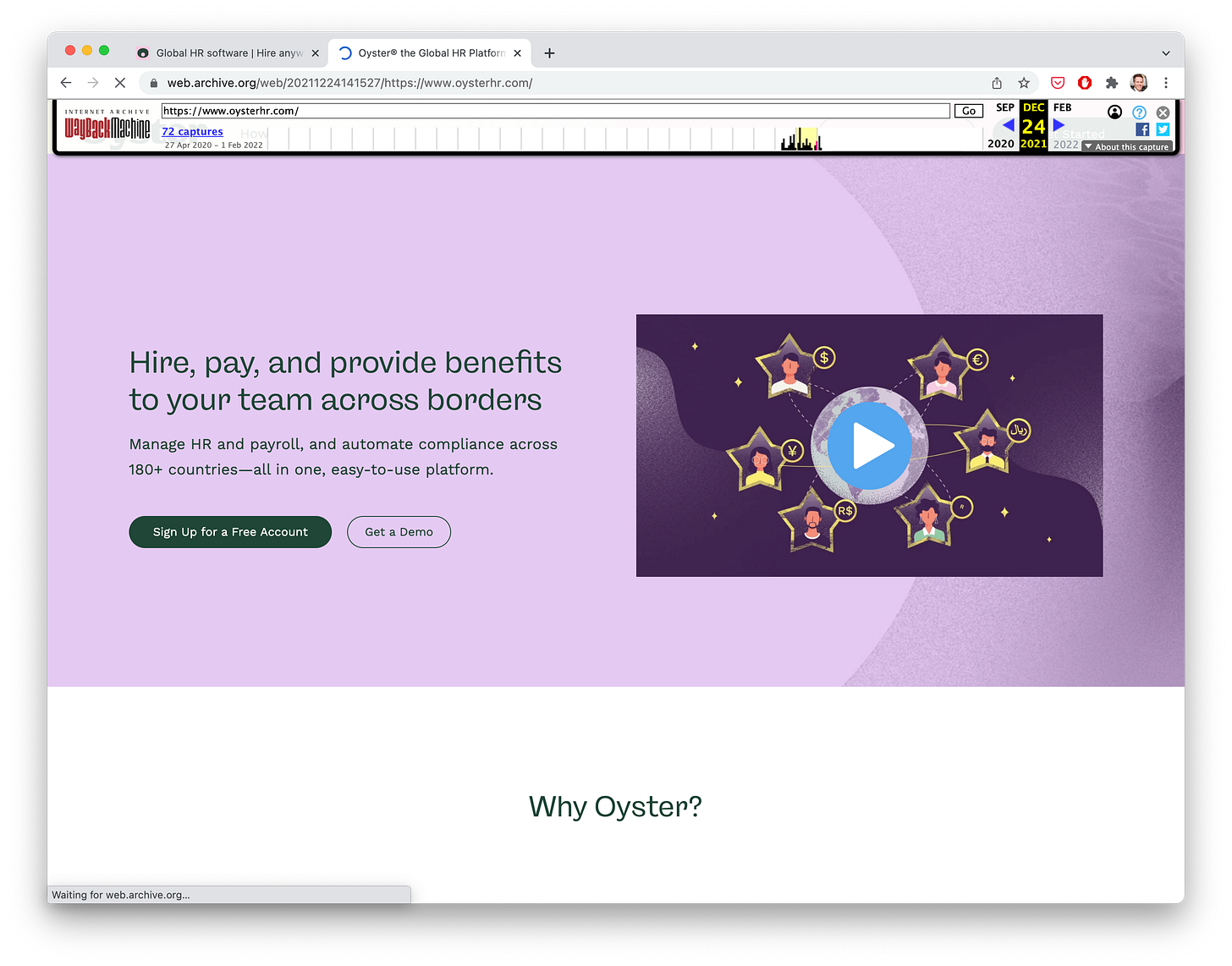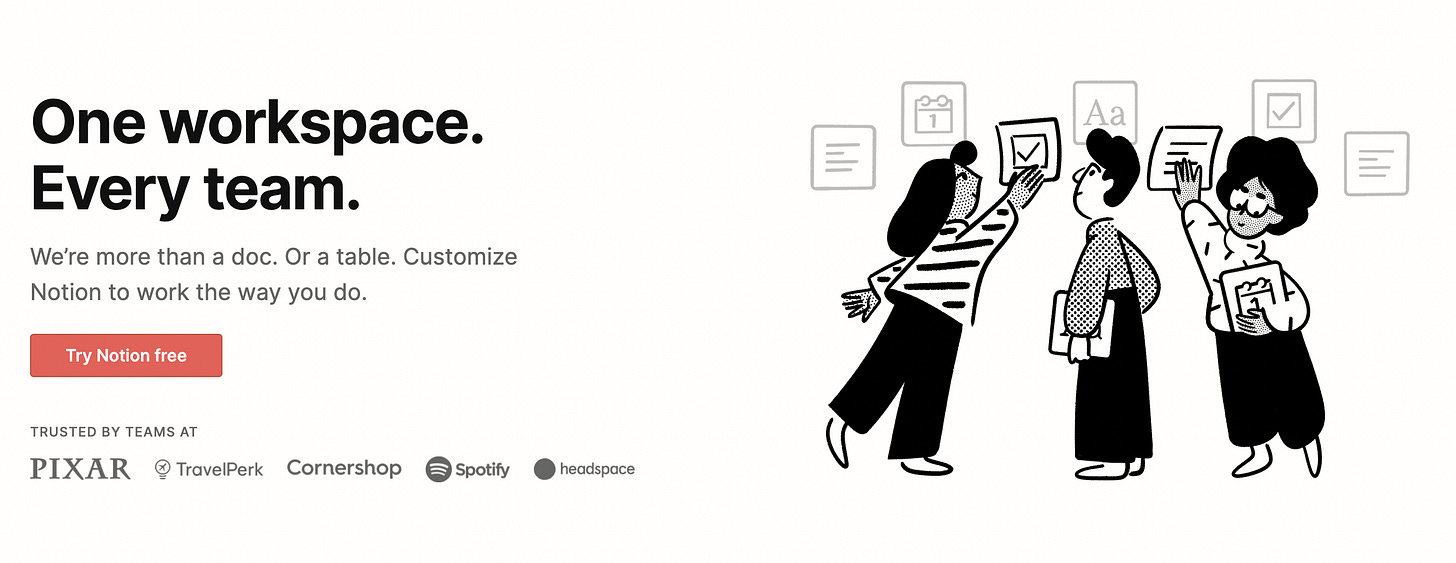306. Benefit ladders 🪜
How to make sure you're always talking benefits first, features second
Hi there 👋
This week’s newsletter is inspired by a conversation I had with a group of marketers, which further inspired me to share with you all the groups of marketers I’m part of. Inspiration inception. :) My conversation this week was with a great group at the On Deck Marketing program. I’m also part of these Slacks, which I can highly recommend.
Demand Curve
ProductLed
On Deck Marketing
Rands
If you’re part of any of these groups, come say hi! I’d love to message with you (but apologies in advance for my slow Slack response times.) Are you part of any marketing Slack groups?
Wishing you a great week,
Kevan
(ᵔᴥᵔ)
Thank you for being part of this newsletter. Each week, I share playbooks, case studies, stories, and links from inside the startup marketing world and my time at Oyster, Buffer, and more.
Say hi anytime at hello@kevanlee.com. I’d love to hear from you.
“People don't buy products. They buy better versions of themselves.”
The above quote (👆) was one of the very first lessons I learned in startup marketing when I was writing product marketing copy at Buffer and writing it, erroneously, features-first.
Enter this article from User Onboard. And this iconic graphic:
When you're trying to win customers, are you listing the attributes of the flower or describing how awesome it is to throw fireballs?
Always communicate the benefits before the features.
BENEFITS → Features.
Benefits > Features.
It’s an easy enough refrain to remember, and when you’re moving at 60 miles per hour in startup land, this framework alone can be enough to bring your copywriting up a notch.
Take the brand new Oyster homepage for instance.
New homepage:
Previous homepage:
Product positioning, messaging, and copywriting is an evolution, so we’re striving to evolve the Oyster message to be more and more benefits-driven as we ourselves get to know our core persona better and the things they find most beneficial. The older version of our homepage remains great and crystal-clear. The newer homepage doubles down on the primary benefit even further — hire anywhere — and then levels it up to an even broader benefit — thriving as an HR leader, a global workforce, and a distributed team.
On the new homepage, we also have this section on what makes Oyster a tool of choice. Any feedback-oriented copywriters reading this? I’d love your feedback.
In this section, we blend of benefits and features. “Hire in days”? Very benefits-driven. “Distributed hiring tools”? A bit more feature-rich. We’ll even mix-and-match within a section, like in-country expertise (which is kind of a feature) that we later explain helps you “provide an exceptional employee experience” (benefit).
All this website work is pinned on the foundation of Benefits > Features, which is a useful enough maxim when you need to move fast on new copy.
But what happens when Benefits > Features needs more of a framework?
There comes a point in every marketing team’s journey when the basics of Benefits > Features no longer cuts the mustard. You need a more robust framework.
This typically happens as the business itself gets more mature and complex. You’ll see this happen across a matrixed grid:
The number of buyer personas or ICPs that you sell to. Typically you start with one ICP, which allows you to have a more nimble Benefits > Features framework.
The nuanced understanding of your customer journey(s). At the start, one message does the job. But as you get more refined with your campaigns, your demand gen, your brand strategy, you’ll want to deliver different messages at different times.
The upper-right quadrant is where marketing teams end up. The lower left is where they start.
So as your messaging gets more and more specialized, you’ll want to introduce some explicit frameworks to help organize and align your messaging, not just within your marketing deliverables but across the entire organization. Think of how powerful it will be when someone in finance, someone in product, and someone in ops can all recite the three datapoints that back up your persona’s desired outcomes.
With that in mind, here are two that I have been getting into. The former one comes highly recommended through some marketing friends, and the latter one we use at Oyster.
Benefit ladders
To better understand the benefits that you offer to each of your customer segments, the Benefit Ladder is a useful framework for building from a consumer need to an emotional outcome. The idea is to work your way from the bottom rung to the top rung and then to take the learnings from the Emotional Benefits and let these infuse your marketing and your brand to help you truly connect with your audience.
This article from Beloved Brands has a great overview of each rung of the ladder.
First, leverage all available consumer research to brief the team. Above all, define the consumer target profile with consumer insights, need states, and the consumer enemy.
Second, brainstorm all possible brand features that your brand offers, plus any brand assets. Focus on the features that give your brand a competitive advantage.
Next, move up to the functional benefits. Put yourself in the shoes of the consumer and for each feature on your list, ask “if I am the consumer, what do I get from that?” Keep asking with answers that differentiate and move into a richer zone.
Finally, move up to the emotional benefits by looking at each functional benefit and ask “so if I am the consumer, how does that make me feel?” Most importantly, keep asking the question until you see a deeper emotional space that you can play in, that will help differentiate your brand.
Core messaging template
When we’re getting ready to build new campaigns or think about GTM for a new release, it’s great to have a core messaging template to consult. Here are the different elements of the template we use at Oyster.
The full template is available here as a Google Doc you can copy.
Value prop
Audience
What is their problem / JTBD
What are their key needs in a solution
What is their demographic
How do they find information
How do they buy products
How do they prefer to be communicated with
Elevator pitch
Long description
Tone of voice
Outcomes: What outcomes are possible because of the product you’ve created? What do you enable the customer to do?
Customer requirements: What does the customer need in order to convert?
Outcome pillars: Each pillar is one-to-three words that should substantiate the elevator pitch and positioning.
Name of pillar
Pain points it addresses
Product benefits
Product features / details
Proof points
Over to you
Are there any messaging frameworks that you’ve used and loved? How do you ensure that your copywriting is infused with benefits before features?
I’d love to hear your thoughts. Feel free to drop me a reply!
Misc.
Notion homepage. What do you think of these headings on the Notion homepage? I hardly ever visit the homepage, so it was fascinating to see how Notion has started positioning itself.
Ogilvy’s social media trends report for 2022. One of the big themes: deeper intent and attention, “a distinctive move towards containing dwell time and buying power within a single experience or platform.”
About this newsletter …
Hi, I’m Kevan, a marketing exec based in Boise, Idaho, who specializes in startup marketing and brand-building. I currently lead the marketing team at Oyster (we’re hiring!). I previously built brands at Buffer, Vox, and Polly. Each week, I share playbooks, case studies, stories, and links from inside the startup marketing world. Not yet subscribed? No worries. You can check out the archive, or sign up below:
Thank you for being here! 🙇♂️
I’m lucky to count folks from great brands like these (and many more) as part of this newsletter community.












